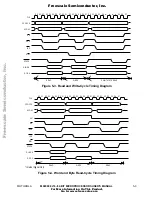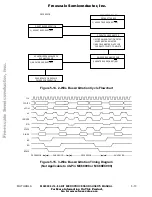
MOTOROLA
M68000 8-/16-/32-BIT MICROPROCESSORS USER'S MANUAL
4- 7
CLK
A23–A0
AS
S0
S1 S2
S3 S4
S5 S6
S7
S8 S9 S10 S11 S12 S13 S14 S15 S16 S17 S18 S19
INDIVISIBLE CYCLE
DS OR LDS
R/W
DTACK
D7–D0
FC2–FC0
Figure 4-6. Read-Modify-Write Cycle Timing Diagram
The descriptions of the read-modify-write cycle states are as follows:
STATE 0
The read cycle starts in S0. The processor places valid function codes on
FC2–FC0 and drives R/
W
high to identify a read cycle.
STATE 1
Entering S1, the processor drives a valid address on the address bus.
STATE 2
On the rising edge of S2, the processor asserts
AS
and
LDS
, or
DS
.
STATE 3
During S3, no bus signals are altered.
STATE 4
During S4, the processor waits for a cycle termination signal (
DTACK
or
BERR
) or
VPA
, an M6800 peripheral signal. When
VPA
is asserted during
S4, the cycle becomes a peripheral cycle (refer to Appendix B M6800
Peripheral Interface). If neither termination signal is asserted before the
falling edge at the end of S4, the processor inserts wait states (full clock
cycles) until either
DTACK
or
BERR
is asserted.
STATE 5
During S5, no bus signals are altered.
STATE 6
During S6, data from the device are driven onto the data bus.
STATE 7
On the falling edge of the clock entering S7, the processor accepts data
from the device and negates
L D S
, and
D S
. The device negates
DTACK
or
BERR
at this time.
STATES 8–11
The bus signals are unaltered during S8–S11, during which the arithmetic
logic unit makes appropriate modifications to the data.
F
re
e
sc
a
le
S
e
m
ic
o
n
d
u
c
to
r,
I
Freescale Semiconductor, Inc.
For More Information On This Product,
Go to: www.freescale.com
n
c
.
..















































